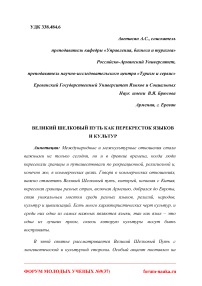The great silk road as crossroads of languages and cultures
Автор: Avetisyan A.S.
Журнал: Форум молодых ученых @forum-nauka
Статья в выпуске: 9 (37), 2019 года.
Бесплатный доступ
International and intercultural relations have become important not just nowadays, but there were like this also in ancient times, when people used to cross borders and travel on recreational, religious and, of course, on commercial purposes. When speaking about the commercial relations, it is important to mention the Great Silk Road, which, having started from China and having crossed the borders of different countries, including Armenia, reached Europe thus becoming a unique bridge among different languages, religions, nations, cultures and civilizations. There are many characteristic features of cultures, and among them one of the most important ones are languages, as the language is one of best prisms through which the culture can be perceived. In this article the Great Silk Road is studied from the linguistic and cultural angles in order to show the relations between different countries. The special emphasis has been put on the words “vordan karmir” and “carpet” and, consequently, on the usage of this special red dye called “vordan karmir” in Armenian and carpets, particularly the oldest best preserved carpet of the world, the Pazyryk rug.
Great silk road, crossroads of cultures and languages, "vordan karmir", carpets, pazyryk carpet
Короткий адрес: https://sciup.org/140287037
IDR: 140287037
Список литературы The great silk road as crossroads of languages and cultures
- Brislin, R., K. Cushner, C. Cherrie, and M. Yong. "Intercultural Interactions". London, 1986
- Brydon, S. and M. Scott. "Between One and Many". London, 2006
- Canale, M. "Language and Communication". London, 2001
- Condon, J. C. and F. Yousef. "An Introduction to Intercultural Communication". New York, 1975
- Gumperz, J. and St., Levinson. "Rethinking Linguistic Relativity". Cambridge, 1996
- Hoopes, D. S. and P. Ventura. "Intercultural Sourcebook: Cross-cultural Training Methodologies". LaGrange, 1979
- Kohls, L. R. "Developing Intercultural Awareness". Washington, 1981
- Kramsch, C. "Language and Culture". Oxford, 2009
- Levinson, G. "Intercultural Understanding". New York, 1985
- Richthofen F. China. Ergebnisse eigener Reisen und darauf gegrundeter Studienm Bd. 1-4, Berlin, 1877-1883, S. 454
- Robinson, G. L."Crosscultural Understanding". New York, 1985
- Rogers, E. and Th., Steinfatt. "Intercultural Communication". Illinois, Waveland, 2007
- Tomalin, B. and S., Stempleski. "Cultural Awareness". Oxford, 2006
- Страбон, География, Ленинград, 1964
- Աճառյան Հր., Հայերեն Արմատական բառարան, հատոր 2, Երևան, 1973 - Hr. Acharyan, Armenian Etymological Dictionary, volume 2, Yerevan 1973
- Գանցհորն Ֆ., Քրիստոնեա-արևելյան Գորգը, Ակունքներից մինչև 18-րդ դարն ընկած պատկերագրական և պատկերագիտական զարգացման ուրվագիծ, թարգմանությունը գերմաներենից՝ Հրաչյա Ստեփանյան, Հայաստանի պատմության թանգարան, Երևան - Volkmar Gantzhorn, Der christlich orientalische Teppich: Eine Darstellung der ikonographischen und ikonologischen Entwicklung von den Anfängen bis zum 18. Jahrhundert, 1991 Benedikt Taschen Verlag
- Հայկական սովետական հանրագիտարան, հատոր 8, Երևան 1982 - Armenian Soviet Encyclopedia, volume 8, Yerevan 1982
- Schurmann U., Der Pazyryk, Seine Deutung und Herkuuft, New York, 1982


